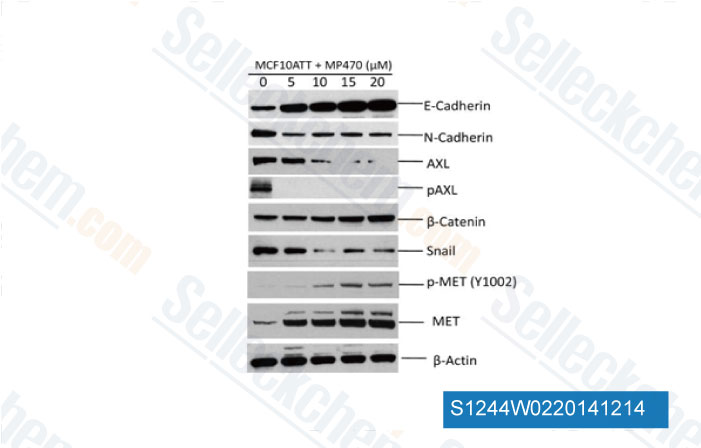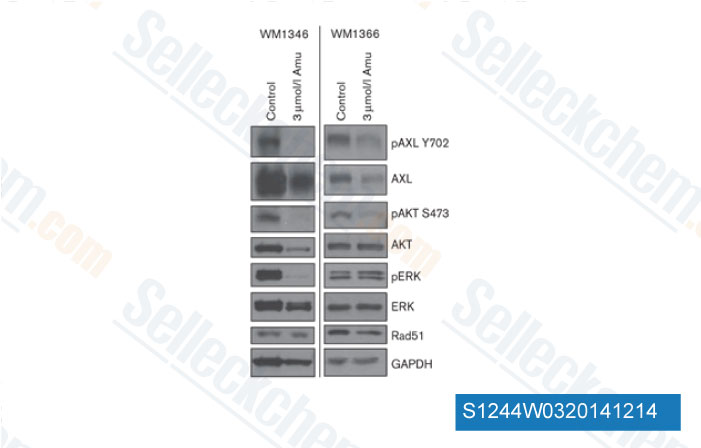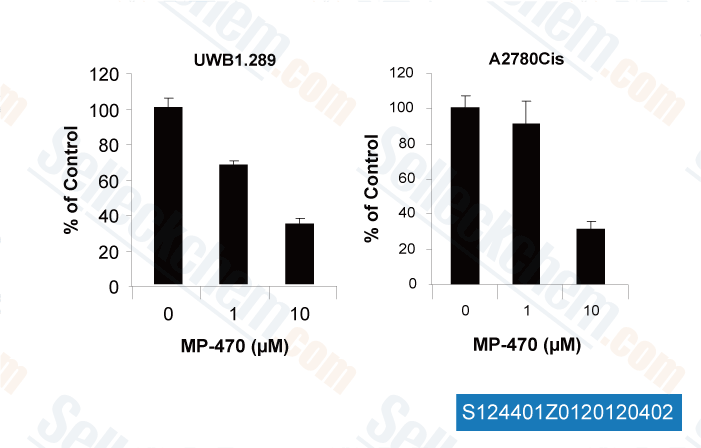|
How to Cite 1. For In-Text Citation (Materials & Methods): 2. For Key Resources Table: |
||
|
Toll Free: (877) 796-6397 -- USA and Canada only -- |
Fax: +1-832-582-8590 Orders: +1-832-582-8158 |
Tech Support: +1-832-582-8158 Ext:3 Please provide your Order Number in the email. We strive to reply to |
Technical Data
| Formula | C23H21N5O3S |
||||||||||
| Molecular Weight | 447.51 | CAS No. | 850879-09-3 | ||||||||
| Solubility (25°C)* | In vitro | DMSO | 90 mg/mL (201.11 mM) | ||||||||
| Water | Insoluble | ||||||||||
| Ethanol | Insoluble | ||||||||||
| In vivo (Add solvents to the product individually and in order) |
|
||||||||||
|
* <1 mg/ml means slightly soluble or insoluble. * Please note that Selleck tests the solubility of all compounds in-house, and the actual solubility may differ slightly from published values. This is normal and is due to slight batch-to-batch variations. * Room temperature shipping (Stability testing shows this product can be shipped without any cooling measures.) |
|||||||||||
Preparing Stock Solutions
Biological Activity
| Description | Amuvatinib (MP-470, HPK 56) is a potent and multi-targeted inhibitor of c-Kit, PDGFRα and Flt3 with IC50 of 10 nM, 40 nM and 81 nM, respectively. It suppresses c-MET and c-RET, and is also active as a DNA repair protein Rad51 inhibitor with antineoplastic activity. Phase 2. | |||||||||||
|---|---|---|---|---|---|---|---|---|---|---|---|---|
| Targets |
|
|||||||||||
| In vitro | The hydrochloride salt of Amuvatinib (MP-470) inhibits several mutants of c-Kit, including c-KitD816V, c-KitD816H, c-KitV560G, and c-KitV654A, as well as a Flt3 mutant (Flt3D835Y) and two PDGFRα mutants (PDGFRαV561D and PDGFRαD842V), with IC50 of 10 nM to 8.4 μM. It also binds to and inhibits several c-Kit mutants, including c-KitK642E, c-KitD816V, and c-KitK642E/D816V. [2] This compound potently inhibits the proliferation of OVCAR-3, A549, NCI-H647, DMS-153, and DMS-114 cells, with IC50 of 0.9 μM–7.86 μM. [1] It also inhibits c-Kit and PDGFRα, with IC50 values of 31 μM and 27 μM, respectively. It demonstrates potent cytotoxicity against MiaPaCa-2, PANC-1, and GIST882 cells, with IC50 of 1.6 μM to 3.0 μM. [2] In MDA-MB-231 cells, it (1 μM) inhibits tyrosine phosphorylation of AXL. [3] In LNCaP and PC-3, but not DU145 cells, it exhibits cytotoxicity with IC50 of 4 μM and 8 μM, respectively, and induces apoptosis at 10 μM. In LNCaP cells, it (10 μM) elicits G1 arrest and decreases phosphorylation of Akt and ERK1/2. [4] In SF767 cells, it (10 μM) inhibits c-Met phosphorylation and sensitizes cells to radiation. In combination with radiation, it (10 μM) inhibits glycogen synthase kinase (GSK)3β activity, induces apoptosis, and disrupts the repair of dsDNA breaks probably through suppression of Rad51. [5] [6] |
|||||||||||
| In vivo | In mice xenograft models of HT-29, A549, and SB-CL2 cells, Amuvatinib (MP-470) (10 mg/kg–75 mg/kg via i.p. or 50 mg/kg–200 mg/kg via p.o.) inhibits tumor growth. [1] In mice bearing LNCaP xenograft, this compound (20 mg/kg) combined with Erlotinib significantly induces tumor growth inhibition (TGI). [4] |
Protocol (from reference)
| Kinase Assay: |
|
|---|---|
| Cell Assay: |
|
| Animal Study: |
|
References
|
Customer Product Validation

-
Data from [ Oncogene , 2014 , 33(10), 1316-24 ]

-
Data from [ Melanoma Res , 2014 , 24(5), 448-53 ]

-
Data from [ Nat Genet , 2012 , 44(8), 852-60 ]

-
, , Dr. Yong-Weon Yi from Georgetown University Medical Center
Selleck's Amuvatinib (MP-470) Has Been Cited by 21 Publications
| Tumorigenesis Driven by BRAFV600E Requires Secondary Mutations that Overcome it's Feedback Inhibition of RAC1 and Migration [ Cancer Res, 2025, 10.1158/0008-5472.CAN-24-2220] | PubMed: 39992718 |
| Synthetic Lethal Combinations of DNA Repair Inhibitors and Genotoxic Agents to Target High-Risk Diffuse Large B Cell Lymphoma [ Hematol Oncol, 2025, 43(5):e70131] | PubMed: 40847617 |
| Tumorigenesis driven by the BRAFV600E oncoprotein requires secondary mutations that overcome its feedback inhibition of migration and invasion [ bioRxiv, 2024, 2023.11.21.568071] | PubMed: 38659913 |
| Amuvatinib Blocks SARS-CoV-2 Infection at the Entry Step of the Viral Life Cycle [ Microbiol Spectr, 2023, e0510522.] | PubMed: 36995225 |
| Establishment and Characterization of NCC-PMP1-C1: A Novel Patient-Derived Cell Line of Metastatic Pseudomyxoma Peritonei [ J Pers Med, 2022, 12(2)258] | PubMed: 35207746 |
| Establishment and characterization of NCC-UPS4-C1: a novel cell line of undifferentiated pleomorphic sarcoma from a patient with Li-Fraumeni syndrome [ Hum Cell, 2022, 10.1007/s13577-022-00671-y] | PubMed: 35118583 |
| βIII-tubulin suppression enhances the activity of Amuvatinib to inhibit cell proliferation in c-Met positive non-small cell lung cancer cells [ Cancer Med, 2022, 10.1002/cam4.5128] | PubMed: 35946957 |
| STING-Mediated Interferon Induction by Herpes Simplex Virus 1 Requires the Protein Tyrosine Kinase Syk [ mBio, 2021, 12(6):e0322821] | PubMed: 34933455 |
| Establishment and characterization of NCC-MFS4-C1: a novel patient-derived cell line of myxofibrosarcoma [ Hum Cell, 2021, 34(6):1911-1918] | PubMed: 34383271 |
| Establishment and characterization of novel patient-derived cell lines from giant cell tumor of bone [ Hum Cell, 2021, 10.1007/s13577-021-00579-z] | PubMed: 34304386 |
RETURN POLICY
Selleck Chemical’s Unconditional Return Policy ensures a smooth online shopping experience for our customers. If you are in any way unsatisfied with your purchase, you may return any item(s) within 7 days of receiving it. In the event of product quality issues, either protocol related or product related problems, you may return any item(s) within 365 days from the original purchase date. Please follow the instructions below when returning products.
SHIPPING AND STORAGE
Selleck products are transported at room temperature. If you receive the product at room temperature, please rest assured, the Selleck Quality Inspection Department has conducted experiments to verify that the normal temperature placement of one month will not affect the biological activity of powder products. After collecting, please store the product according to the requirements described in the datasheet. Most Selleck products are stable under the recommended conditions.
NOT FOR HUMAN, VETERINARY DIAGNOSTIC OR THERAPEUTIC USE.
